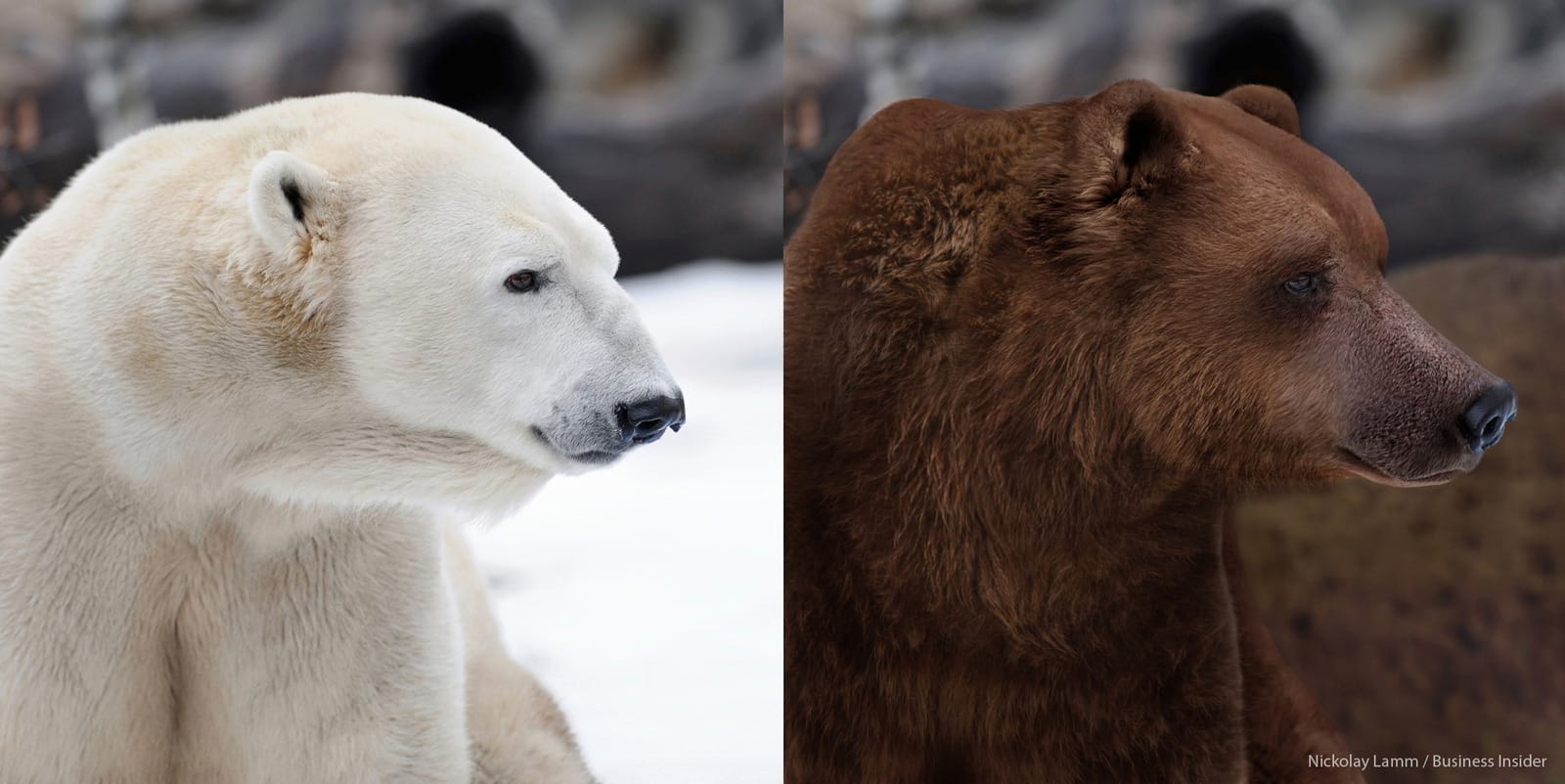Unleashing the Titans: Kodiak vs. Polar Bear
It’s the ultimate wildlife face-off: the massive Kodiak bear versus the icy Polar bear. Both are apex predators, ruling their respective domains with strength and power. But what if these titans clashed? Let’s delve into their stats, skills, and chances of survival in this epic showdown.
Size and Strength: A Heavyweight Bout
- Kodiak Bear: These muscular giants can weigh anywhere from 600 to 1,500 pounds and stand over 8 feet tall.
- Polar Bear: While slightly shorter on average, Polar bears can reach a staggering 1,600 pounds.
Both bears are incredibly strong, but their power manifests in different ways. Kodiak bears rely on raw strength, similar to a heavyweight boxer, while Polar bears are more agile, like wrestlers, adapted for speed and maneuverability on ice and in water.
Home Turf Advantage: Forests vs. Ice Floes
- Kodiak Bear: These bears thrive in the lush forests and salmon-rich rivers of Alaska’s Kodiak Archipelago.
- Polar Bear: Ruling the frozen Arctic, Polar bears are perfectly adapted to icy waters and desolate landscapes.
The environment would play a crucial role in a battle. A Kodiak bear would have the advantage on land, while a Polar bear would dominate in water or on ice.
Dinner Time: Salmon Buffets and Seal Snacks
- Kodiak Bear: These bears enjoy a varied diet of salmon, berries, and scavenged food, contributing to a more social lifestyle with some social structures.
- Polar Bear: Their diet primarily consists of seals, hunted on ice, leading to a solitary life focused on securing their next meal.
This difference in diet and lifestyle means that Kodiak bears are used to more social interaction, while Polar bears are solitary hunters, fiercely defending their territories.
So, Who Takes the Crown?
In reality, a Kodiak bear and a Polar bear are unlikely to meet in the wild due to their vastly different habitats. However, in a hypothetical battle, there is no easy answer.
- Kodiak Bear: Boasts greater size and raw power, potentially giving it an edge in a land-based confrontation.
- Polar Bear: Its agility, swimming skills, and predatory experience hunting large prey could give it an advantage in a prolonged battle, especially in water or on ice.
The outcome would likely depend on many factors, including individual strength, experience, the environment, and even a bit of luck.
The Bigger Picture: Beyond the Hypothetical Battle
While the idea of a Kodiak bear versus a Polar bear is captivating, it’s essential to consider the bigger picture. These animals face real threats from climate change, habitat loss, and human-wildlife conflict. By understanding their unique adaptations and ecological roles, we can better appreciate these magnificent creatures and work towards their conservation.
Is a Kodiak Bear Stronger Than a Polar Bear?
The question of strength isn’t easily answered. Both Kodiak and Polar bears are powerhouses in their own right, their strengths shaped by their environment and hunting styles.
- Kodiak Bear: Their massive size and powerful limbs suggest a higher strike force, capable of overpowering prey with brute strength. Their bite force, estimated at around 975 psi, is comparable to a grizzly bear.
- Polar Bear: While their exact bite force remains unmeasured, their predatory tactic of crushing skulls suggests a powerful bite adapted for their prey. Their agility and speed on ice, combined with their swimming stamina, make them formidable hunters in their domain.
While a Kodiak bear may have the edge in raw power, a Polar bear’s agility and hunting experience could prove advantageous in a fight. Determining a definitive “stronger” bear is difficult as their strengths are tailored to their unique environments.
What Animal Could Beat a Kodiak Bear?
While Kodiak bears are formidable creatures, the animal kingdom holds other contenders that could potentially defeat them:
- Polar Bear: As discussed, the Polar bear’s agility, swimming skills, and hunting experience could give it an edge in a prolonged battle, particularly in water or on ice.
- Siberian Tiger: The largest cat species, Siberian tigers are known for their stealth, agility, and powerful bites. While significantly smaller than a Kodiak bear, a well-placed ambush could prove fatal.
- Large Bull Elephant (African Bush Elephant): With unmatched size and strength in the animal kingdom, an elephant could potentially crush a Kodiak bear. However, such a confrontation is improbable due to their different habitats.
- Hippopotamus: Highly aggressive and territorial, hippos possess massive jaws and teeth. They could pose a significant threat in water or near the water’s edge.
- Killer Whale: In the water, the killer whale reigns supreme. These intelligent predators are known for their strategic hunting and could easily outmaneuver a Kodiak bear in the open ocean.
It’s important to remember that animal battles are complex and depend on various factors, including environment, age, experience, and the element of surprise.
What’s the Most Aggressive Bear?
Determining the “most aggressive” bear species is challenging as aggression is influenced by numerous factors, including:
- Species: Inherent behavioral traits vary between species, shaped by their evolutionary history and environment.
- Habitat and Food Availability: Scarcity of resources can lead to increased competition and aggression.
- Seasonality: Mating season and times when cubs are present often coincide with heightened protective instincts.
- Human Behavior: Encroachment on territory, improper food storage, and approaching cubs can trigger defensive aggression in any bear species.
While Kodiak and Polar bears are often perceived as the most aggressive due to their size and predatory nature, other contenders exist:
- Grizzly Bears: Known for their unpredictable temperament, Grizzly bear attacks on humans are documented, though often defensive.
- Sloth Bears: Surprisingly aggressive despite their smaller size, Sloth bears are often triggered by human disturbance, particularly near their food sources.
- Black Bears: Generally less aggressive than brown bears, Black bear attacks can occur, especially if a mother perceives a threat to her cubs.
Instead of ranking bears by aggression, understanding the factors that trigger aggressive behavior is crucial for safe coexistence. By respecting their space, practicing responsible tourism in bear country, and supporting conservation efforts, we can minimize human-wildlife conflict and appreciate these incredible creatures.
- Crypto Quotes’ Red Flags: Avoid Costly Mistakes - June 30, 2025
- Unlock Inspirational Crypto Quotes: Future Predictions - June 30, 2025
- Famous Bitcoin Quotes: A Deep Dive into Crypto’s History - June 30, 2025

















1 thought on “Kodiak Bear vs. Polar Bear: Who Would Win in an Epic Showdown?”
Comments are closed.